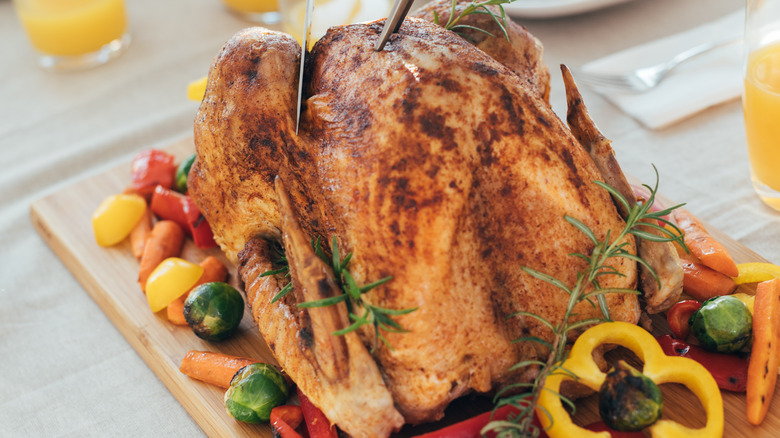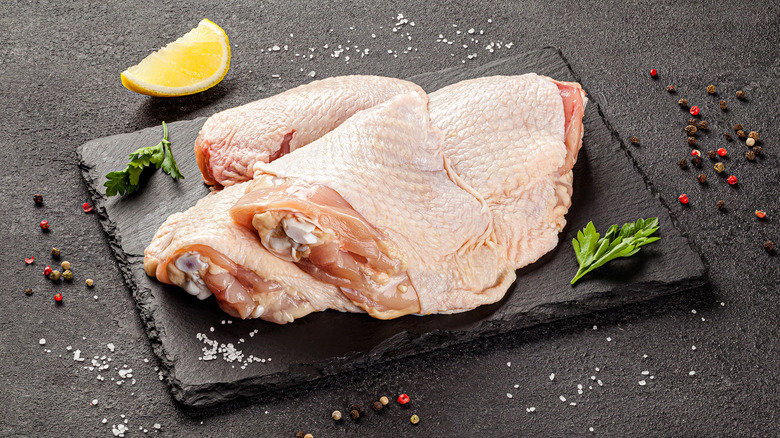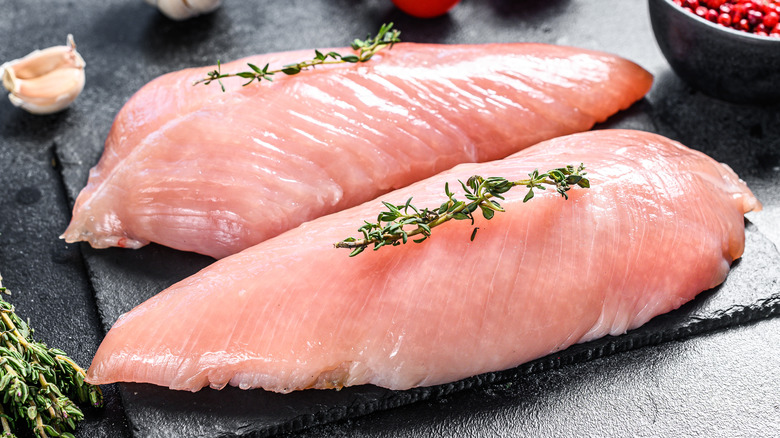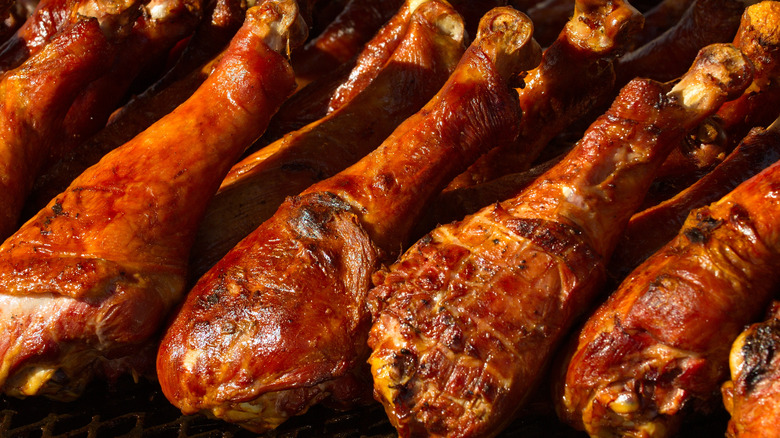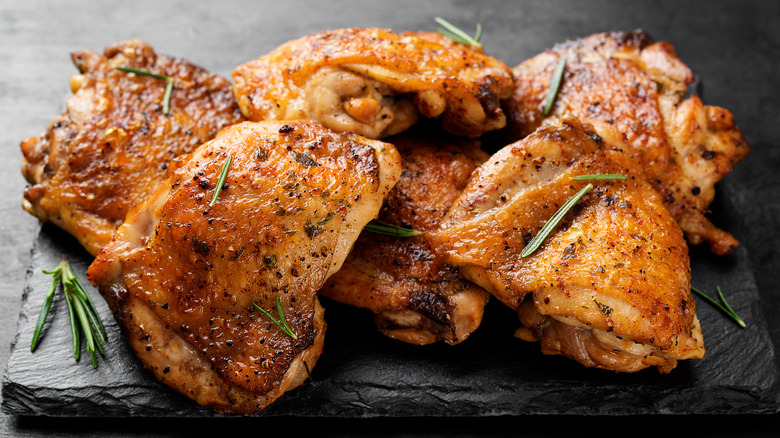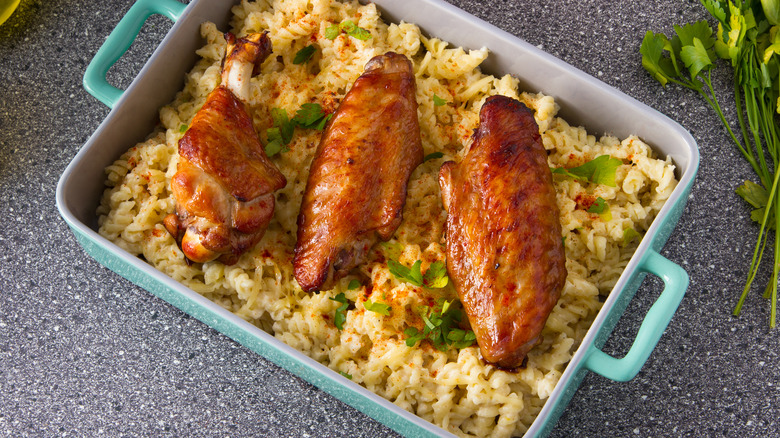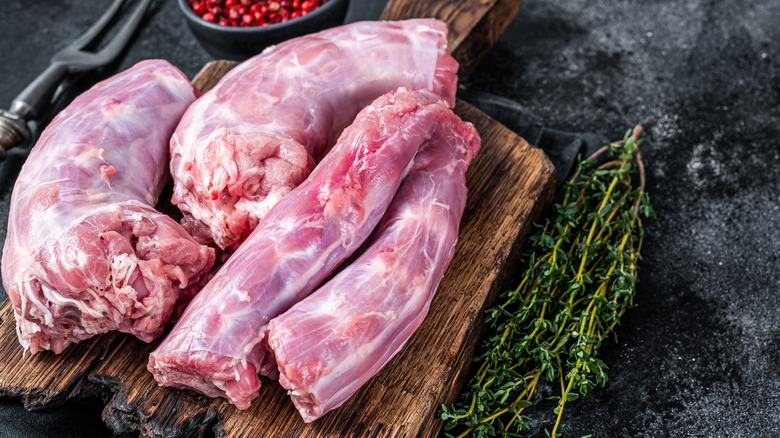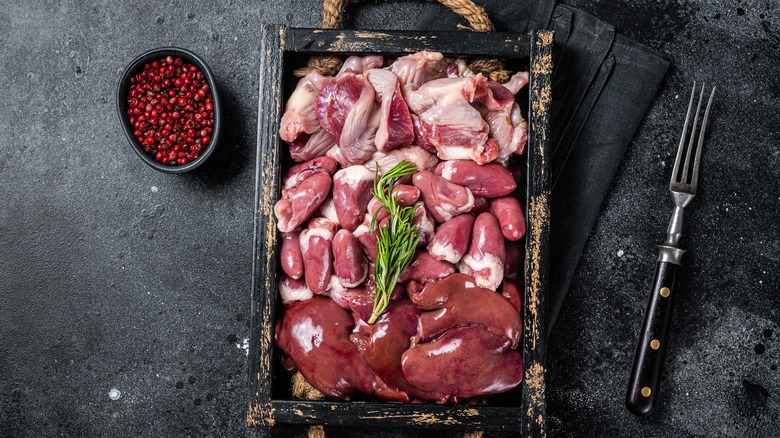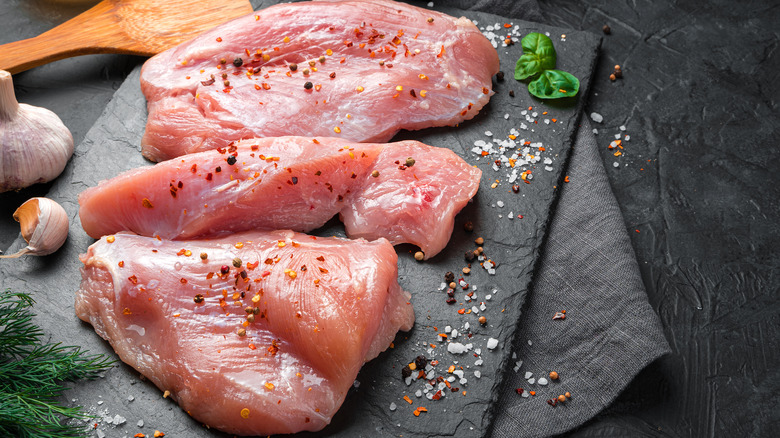8 Cuts Of Turkey You Should Know
The Thanksgiving meal is an event that can have even the most experienced chefs quivering in their Crocs. Despite the pressure of delivering the perfectly cooked Thanksgiving turkey, this bird mustn't be so scary. To handle this bird, we must break it into pieces and understand what each cut brings to the feast.
Whether you're cooking for a huge crowd or just a few turkey and stuffing lovers, knowing the different turkey cuts and how they're best prepared can make your home-cooked feast a breeze. A turkey comprises white meat and dark meat, from the top of the breasts to the bottom of the drumsticks. And in between all of that, there's a lot going on. You've got breasts with bones and without, tenderloins, legs, wings, necks, and even giblets, all of which have different needs. Plus, if cooking a whole bird just isn't in the cards, each turkey cut can be prepared independently, delivering a fantastic meal without the pressure of cooking the whole bird.
Bone-in Breast
It's tough for the bone-in breast on a turkey to get as much attention as it deserves when the boneless breast is so often the star of the show, but this is a cut of meat that shouldn't be ignored. If you're cooking for a smaller crowd this Thanksgiving, going with a couple of bone-in turkey breasts instead of a whole bird is a great way to feed your guests a moist, delicious turkey dinner without all the fuss.
Known also as the turkey crown, a bone-in turkey breast will include the double breast of the turkey with the ribs intact but with the legs and wings removed. If the idea of cooking a turkey breast sounds intimidating, fear not. Unlike its boneless counterpart, the bone in the breast acts as an insulator during the cooking process, causing the meat to heat slower and stay moist and juicy throughout. Plus, the cooking time for the bone-in breasts is much quicker than the whole bird, so if pacing around your kitchen isn't your idea of a good time, this cut is for you.
Boneless Breast
Cooking a boneless turkey breast to perfection is a feat for any chef, from the restaurant kitchen to the home kitchen. The turkey breast is the (boneless) backbone of the bird that makes a beautifully cooked Thanksgiving turkey really shine, but because of its lack of bone structure, it is almost too easy to overcook, resulting in something dry and stringy instead of moist and juicy.
If you're cooking your bird whole, the key to keeping the breasts from drying out is obviously to avoid overcooking (you can make sure you don't overcook by investing in a quality meat thermometer) but to ensure moisture gets in throughout the cooking process. You've got options: You can brine your bird before cooking, you can lift up the skin on the turkey and stuff it with butter to allow the fat to melt into the meat, or you can even roast the whole turkey upside down to let the fat from the bird run down into the breast meat.
Looking to just cook boneless turkey breasts for Thanksgiving instead of a whole bird? Here's where you can focus all your efforts on just one cut of meat without worrying about how the rest of the bird cooks. For a simple turkey breast recipe to ensure a moist, juicy result every time, pound it thin, stuff it with buttery vegetables and savory sausage, and roll it into a roulade.
Leg/Drumstick
The iconic turkey drumstick is, unsurprisingly, a fan favorite when it comes to Thanksgiving turkey lovers and Renaissance festival-goers alike. But, the drumstick doesn't stand alone; the entire turkey leg is made up of the drumstick, which is the part of the leg below the knee and the turkey thigh. Unlike the white meat on a turkey, this dark meat darling won't overcook quite as easily despite needing more time in the oven. As a result of the low and slow method, the drumstick delivers tender, flavorful bites of meat every time.
The best part of the turkey leg? It's not only a less expensive cut of meat than the more common turkey breast, but it's packed with excellent flavor that doesn't require much prep work. The best way to successfully cook turkey legs is by roasting, grilling, and smoking. With the right amount of salt and fat to lock in flavor and juiciness, this may just be your new favorite turkey part.
Thigh
Thanksgiving can be frustrating for people who firmly believe that turkey is just, well, not that good. And we firmly believe those people have yet to try the turkey thigh, which should be considered the real treasure of this celebratory bird. Not only is the thigh meat juicy and tender (and nearly impossible to dry out), but it's lower in fat than the rest of its dark meat brethren, making it one of the most desirable cuts of meat on the whole bird.
When cooked just right, the turkey thigh shines a light on all the good that the turkey has to offer. In addition to that tender meat within, the thick layer of skin on top should also be tended to. Dry it thoroughly with a paper towel, then bathe in fat — butter or oil, it's entirely up to you — and aromatics to achieve a shatteringly crisp texture with incredible flavor. And if the versatility of this meaty cut isn't enough, turkey thighs take far less time to cook than the rest of the bird and can handle a higher oven temperature.
If you prepare your thighs separately, roast them uncovered in a 450 F oven for 20 minutes and then another 30 minutes loosely covered with aluminum foil to keep the skin from burning.
Wing
One of the larger cuts of the bird, turkey wings have the potential to be a meal all on their own and have far more meat on the bones than the smaller and more well-known chicken wing. While they are technically a member of the white meat family, turkey wing meat is richer and meatier than the rest of its white meat compatriots and has more than enough skin to salt and crisp up for additional texture and crunch.
The turkey wing is actually made up of a few parts, starting with the drummette. The drummette is the top part of the wing, similar in size to chicken drummettes. Connected to the drummette is the middle wing, or the flat, which is longer and flatter than the drummette and has two bones inside. Finally, you've got the wing tip, which, if you buy your bird whole, will be hanging out on the end of the flat, and you can choose to keep them on or trim them off before cooking. If you do keep the tips on, wrap them in foil while in the oven so they don't burn.
Neck
The turkey neck is the unsung hero of this celebratory bird. If you've ever bought a whole turkey and simply tossed out the neck bone, you're doing it all wrong. Unlike a chicken neck, a turkey neck is large and packed with tender, juicy meat that falls off the bone and has far more savory flavor than the rest of the white and dark meat on the turkey. Additionally, it's rich in collagen, making it a necessary addition to savory soups, broths, and gravies to provide depth of flavor and turkey meat essence.
If you're buying a whole turkey for your Thanksgiving feast, you'll find the neck bone tucked inside the turkey cavity, most likely in a plastic bag with the rest of the turkey giblets. It may not look like much when raw, but when properly cooked, the tender, juicy meat is extremely versatile: Use it in sautéed greens, turkey soup, or a rich, flavorful bone broth. You can also go ahead and treat yourself to a chef snack by gnawing that meat right off the bone.
Giblets
You buy your whole Thanksgiving turkey, bring it home, unwrap it, and there inside the cavity is a plastic bag filled with ... things. If you're unfamiliar with what this bag of goodies includes, we're here to help you out: It's the turkey giblets. The giblets include the heart, liver, and gizzard (the gizzard helps the bird digest its food), and while they may seem rather off-putting and unnecessary to a Thanksgiving feast, they are anything but.
The first thing you should do with them? If they're in a plastic bag, remove them from the turkey. Per the University of Arkansas Division of Agriculture, cooking your plastic-wrapped giblets inside your turkey can release harmful chemicals into the meat, rendering your whole turkey and the giblets inedible.
So, now what? Well, you have some options. On their own, they can be pretty chewy and unappetizing, so we recommend zhuzhing them up a bit. You can fry or stew them or even turn them into a luscious curry. Our recommendation? Use them in your accompanying turkey gravy, which will benefit greatly from the addition of these tasty treats. Slow-cooked with onions, garlic, and chicken stock, cooking the giblets overnight will tenderize those chewy bites into tender, savory morsels that will add deep, meaty flavor to your gravy.
Tenderloin
Pork tends to be the go-to protein when we think of the tenderloin of an animal, but don't let swine take all the glory. The turkey tenderloin, while not quite the star of the whole bird, is packed with flavor, easy to prepare, and a great cut to use if your Thanksgiving dinner isn't going to be a big affair. The turkey tenderloin lies between the two breasts; boneless and skinless, it's a thick strip of white meat that is one of the healthier turkey cuts. If you're just not feeling the idea of cooking an entire bird, making the turkey tenderloin is a great alternative that cuts out a lot of the prep and cook time, but with an equally delicious result.
Unlike a turkey thigh or leg, the turkey tenderloin is a slightly more finicky cut of meat that can be overcooked if not tended to correctly. Because of this, make sure to keep your oven temperature low as you cook it to ensure the meat doesn't dry out. The rest is really up to you, use your favorite aromatics to add flavor to the meat, and don't forget to serve it alongside some mashed potatoes and roasted autumn vegetables to complete the meal.
